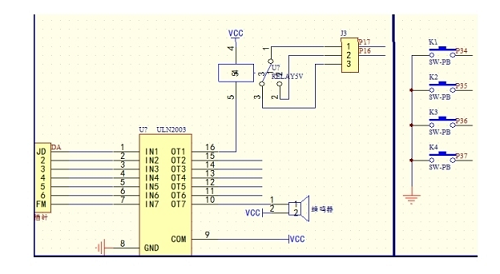Important changes to forums and questions
All forums and questions are now archived. To start a new conversation or read the latest updates go to forums.mbed.com.
6 years, 11 months ago.
The Parameter Testing of Relay
Good morningsir.Could you help me solve my troubles about Relay?
Please look at the following picture,the circuit is controlled by 51 MCU,the key control and measure the pull-in voltage of 5V relay. Including the smallest system model,the 74HC595 drive display module of digital tube while PCF8591AD/DA change module, power supply module is 5V. ULN2003( The ULN2003's pdf: http://www.kynix.com/uploadfiles/pdf9675/ULN2003A.pdf ) drive the rely module.Now it met some troubles. The pull-in voltage is 2V,but the number I measured is 3.6V which showed in multimeter . I think maybe my circuit is wrong and I estimate the voltage I measure is belongs to ULN2003 but not relay. Is my thought right? How to modify it?


Please give me some suggestions,thanks a million.
1 Answer
6 years, 11 months ago.
hi ling ling,
I'm not sure I fully understand your question. I think you're asking if you can change the pull-in voltage of the relay?
I don't know the part # of your relay, but you can certainly expect variation from one part to another. For what would be considered a 5v relay, if you look more closely at the data sheet, you should find a specification for the pull-in voltage and also a release voltage. For one 5v relay I randomly chose (a Kemet EC2 series part), the pull-in was 3.75v and the release voltage was 0.5v. So, all parts shall work at 3.75v and higher, but you will find that most also pull-in at some voltage less than 3.75 (this is how they guarantee the 3.75v pull-in).
For the ULN2003, there will be some voltage drop between the collector and emitter, and this too has quite a variance, depending generally on how much current it is driving. This could range from under 0.9v to over 1.6v.
Using the example Kemet relay, it is quite a low current device, so the ULN2003 should be at or below the 0.9v spec.
Putting the ULN2003 together with the Kemet relay, you can then calculate that you would need at least 3.75 + 0.9v = 4.65v to guarantee operation.
In a more industrialized application, you might also need to factor the temperature where your device operates, and how that can influence the specifications.
If you can remove your relay from the circuit, and place it on a variable power supply, you should have an easier time checking its behavior. Then, as an independent check, with the relay back in the circuit, you could measure the voltage across the ULN2003.
Hopefully, this is what you are looking for, and you'll be able to find the specifications for the relay that you use.